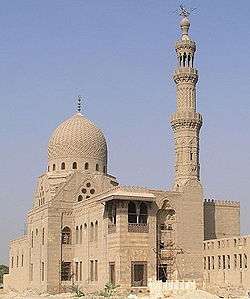Emir Qurqumas Complex
| Emir Qurqumas Complex | |
|---|---|
|
The funeral complex of Qurqumas | |
| Basic information | |
| Location | Cairo, Egypt |
| Affiliation | Islam |
| Architectural description | |
| Architectural style | Mamluk architecture |
| Completed | 1456 |
| Specifications | |
| Minaret(s) | 1 |
The Emir Qurqumas Complex is located in Medieval Cairo, Egypt, in the City of the dead.[1] It is one of the largest mausoleums in Cairo.
Overview
About 200 meters south of Qansuh's tomb stands a massive complex which is actually two mausoleums joined together. That on the north is sultan Inal's. Built in 1450–1456, it is in a ruinous state but is a good example of a Mamluk mausoleum, with a domed funeral chamber, a Madrasa, a Sabil, a monumental door, and a minaret. The complex also includes a Khanqah, or monastery for the Sufi Darvishes. Inal had been a slave of Sultan Barquq and could neither read nor write. He ruled from 1453 to 1460 and does not appear to have any distinction other than his lack of education. Adjoining Inal's Mausoleum is that of Qurqumas, built in 1507. It is in a much better condition and more elegant that Inal's, which is heavier in style.
Qurqumas
Qurqumas was the commander-in-chief of the armies, also called Grand Amir, at the time of his death in 1510, the following is Ibn Iyas describing his funeral, where the four qadis (judges) attended, and it was a funeral without equal. Qurqumas enjoyed the respect and the consideration of all. A former Mameluk of Ashraf Qaitbay, he was manumitted by that monarch and subsequently progressed through promotions, beginning with the job of second equerry. He had been a commander of a thousand, commander of the guard, and appointed governor of the province of Aleppo, under the reign of Amir Tumanbay, when the latter was proclaimed Sultan of Syria. He suffered a common fate.
